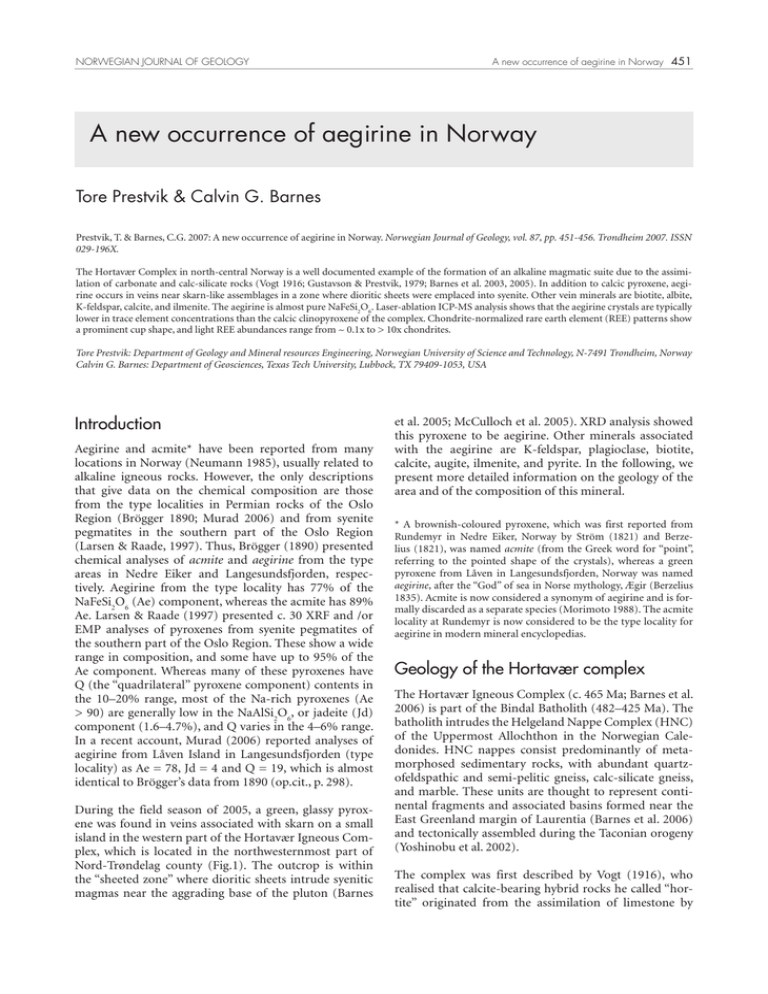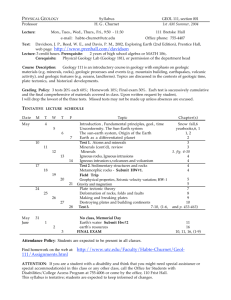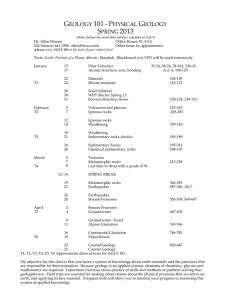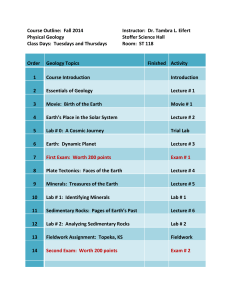A new occurrence of aegirine in Norway Introduction
advertisement

NORWEGIAN JOURNAL OF GEOLOGY A new occurrence of aegirine in Norway 451 A new occurrence of aegirine in Norway Tore Prestvik & Calvin G. Barnes Prestvik, T. & Barnes, C.G. 2007: A new occurrence of aegirine in Norway. Norwegian Journal of Geology, vol. 87, pp. 451-456. Trondheim 2007. ISSN 029-196X. The Hortavær Complex in north-central Norway is a well documented example of the formation of an alkaline magmatic suite due to the assimilation of carbonate and calc-silicate rocks (Vogt 1916; Gustavson & Prestvik, 1979; Barnes et al. 2003, 2005). In addition to calcic pyroxene, aegirine occurs in veins near skarn-like assemblages in a zone where dioritic sheets were emplaced into syenite. Other vein minerals are biotite, albite, K-feldspar, calcite, and ilmenite. The aegirine is almost pure NaFeSi2O6. Laser-ablation ICP-MS analysis shows that the aegirine crystals are typically lower in trace element concentrations than the calcic clinopyroxene of the complex. Chondrite-normalized rare earth element (REE) patterns show a prominent cup shape, and light REE abundances range from ~ 0.1x to > 10x chondrites. Tore Prestvik: Department of Geology and Mineral resources Engineering, Norwegian University of Science and Technology, N-7491 Trondheim, Norway Calvin G. Barnes: Department of Geosciences, Texas Tech University, Lubbock, TX 79409-1053, USA Introduction Aegirine and acmite* have been reported from many locations in Norway (Neumann 1985), usually related to alkaline igneous rocks. However, the only descriptions that give data on the chemical composition are those from the type localities in Permian rocks of the Oslo Region (Brögger 1890; Murad 2006) and from syenite pegmatites in the southern part of the Oslo Region (Larsen & Raade, 1997). Thus, Brögger (1890) presented chemical analyses of acmite and aegirine from the type areas in Nedre Eiker and Langesundsfjorden, respectively. Aegirine from the type locality has 77% of the NaFeSi2O6 (Ae) component, whereas the acmite has 89% Ae. Larsen & Raade (1997) presented c. 30 XRF and /or EMP analyses of pyroxenes from syenite pegmatites of the southern part of the Oslo Region. These show a wide range in composition, and some have up to 95% of the Ae component. Whereas many of these pyroxenes have Q (the “quadrilateral” pyroxene component) contents in the 10–20% range, most of the Na-rich pyroxenes (Ae > 90) are generally low in the NaAlSi2O6, or jadeite (Jd) component (1.6–4.7%), and Q varies in the 4–6% range. In a recent account, Murad (2006) reported analyses of aegirine from Låven Island in Langesundsfjorden (type locality) as Ae = 78, Jd = 4 and Q = 19, which is almost identical to Brögger’s data from 1890 (op.cit., p. 298). During the field season of 2005, a green, glassy pyroxene was found in veins associated with skarn on a small island in the western part of the Hortavær Igneous Complex, which is located in the northwesternmost part of Nord-Trøndelag county (Fig.1). The outcrop is within the “sheeted zone” where dioritic sheets intrude syenitic magmas near the aggrading base of the pluton (Barnes et al. 2005; McCulloch et al. 2005). XRD analysis showed this pyroxene to be aegirine. Other minerals associated with the aegirine are K-feldspar, plagioclase, biotite, calcite, augite, ilmenite, and pyrite. In the following, we present more detailed information on the geology of the area and of the composition of this mineral. * A brownish-coloured pyroxene, which was first reported from Rundemyr in Nedre Eiker, Norway by Ström (1821) and Berzelius (1821), was named acmite (from the Greek word for “point”, referring to the pointed shape of the crystals), whereas a green pyroxene from Låven in Langesundsfjorden, Norway was named aegirine, after the “God” of sea in Norse mythology, Ægir (Berzelius 1835). Acmite is now considered a synonym of aegirine and is formally discarded as a separate species (Morimoto 1988). The acmite locality at Rundemyr is now considered to be the type locality for aegirine in modern mineral encyclopedias. Geology of the Hortavær complex The Hortavær Igneous Complex (c. 465 Ma; Barnes et al. 2006) is part of the Bindal Batholith (482–425 Ma). The batholith intrudes the Helgeland Nappe Complex (HNC) of the Uppermost Allochthon in the Norwegian Caledonides. HNC nappes consist predominantly of metamorphosed sedimentary rocks, with abundant quartzofeldspathic and semi-pelitic gneiss, calc-silicate gneiss, and marble. These units are thought to represent continental fragments and associated basins formed near the East Greenland margin of Laurentia (Barnes et al. 2006) and tectonically assembled during the Taconian orogeny (Yoshinobu et al. 2002). The complex was first described by Vogt (1916), who realised that calcite-bearing hybrid rocks he called “hortite” originated from the assimilation of limestone by 452 T. Prestvik & C.G. Barnes NORWEGIAN JOURNAL OF GEOLOGY central Horta intrusive units RNC Kvingra group Vegflesa Vega 6 15 l. Måsøya Sølbuflesa 6 anatectic granite Fuholmen Korgen Langfallet MOSJØEN Bindalsflesa host rocks en RNC Bindalsflesena sheeted and mingled diorite + syenite 12 d fjor Hortavær Sklinna Hattfjelldal Ve lfjo rd BRØNNØYSUND 18 72 tn va ss Rø Eiterådalen Langflesa na a Ve fsn fjo rd islands not visited olivine gabbro 6 Ra nn Dø Tennholmen monzonite-syenite unit Legeren Sw ed en hybrid melasyenite, etc. No rwa y gneissic granite quartz monzonite Finland syenitic unit dioritic unit MO I RANA a Sjon KNC 37 UTM zone 32 HNC d Bin mixed migmatite and granite als fjo rd n se To Majavatn Leka st. Rundholmen Kviksholmen migmatitic gneiss foliation in xeno; wall rx quartzite magmatic foliation syenite st. Måsøya Flatskj aegirine locality 2 Raudholmen 45 2 4 42 56 5 ? Harran 0 25 km Svartskj 54 42 1 70 58 40 Ørnholmen Sandøya Langdraget 80 36 72 46 25 46 72 45 34 Andersøya Kvåholmen 19 64 80 Klovholmen Oddskj Hundskj 5 Stokksholmen 3 l. Klungholmen 80 74 3 Anatectic (”S-type”) granitoids Peraluminous +/- tourmaline granites Granite, granodiorite Quartz monzonite, syenite Porphyritic granite Porphyritic granodiorite Diorite, tonalite, granodiorite, trondhjemite Gabbro, diorite, monzodiorite Meta-supracrustal rocks of the HNC Metasupracrustal rocks of the RNC Greenstone, gabbro, ultramafic rocks Leka ophiolite complex Køli Nappe Complex Western Gneiss Region Thrust / inferred thrust st. Klungholmen Lågøyskj 4 Sylskj 66 va Bo ya rø Valholmen 71 Vågøya 70 Burøya Dreplan Grøningen Kvingra 66 Storfornøyta Langdraget 57 Purkskj 47 Fornøyta 34 Enholmen Fallborøya 50 Måøya Rørsholmen Namsskogan Vikna marble l. Rundholmen 1 Kvaløy Kalvøy Abrahamskj 65 Tannaren syenite, quartz monzonite, and granite 46 Små fornøyta 65 60 Kleppan 80 Leiskj diorite Båsen Skarvflesa Skarvflesa sheeted zone 72 2 km 31 UTM zone 32 Fig 1. Map of the Hortavær Igneous Complex diorite and gabbro. Gustavson & Prestvik (1979) revealed the alkaline nature of syenite and that the complex was zoned. Newer studies (Barnes et al. 2005) show that the Hortavær Complex is layered or sheeted and consists of multiples (100s or 1000s) of sheets. In the western zone, the sheets are predominantly syenitic (Fig. 1). Dioritic sheets become abundant in the “sheeted zone” and diorite is the predominant rock type in the central zone. East of the central zone, monzonite and syenite become more abundant and are cut by numerous granitic dikes. The easternmost part of the complex (Kvingra) is underlain by foliated, riebeckite-bearing granite and monzonite. Despite the presence of riebeckite, the Kvingra granites and granitic dikes are not peralkaline; they are classified as alkaline to alkali-calcic according to the classification of Frost et al. (2001) and straddle the metaluminousperaluminous boundary. Only three of 39 samples have normative acmite (all with < 0.95 Ac). Host rocks, which are exposed to the west of the complex and as screens and xenoliths within the complex, consist of migmatitic gneiss, calc-silicate gneiss, quartzite, and marble. Pyroxene is a common mineral in both the basic (gabbro and diorite) and intermediate rocks (monzonite and syenite) of Hortavær. Based on optical methods, Vogt (1916) described several types of pyroxene, i.e. “violette augit”, “grüne augit”, and “ægirinaugit”. The latter mineral was described only from one locality, the islet of Kiklakken in the central zone, which is underlain by diorite, syenite and granite. Vogt (1916) did not refer to what rock type the “ægirinaugit” occurred in, but Gustavson & Prestvik (1979) inferred that the “ægirinaugit” was identical to the very iron-rich pyroxene they found in both melasyenite and syenite. This pyroxene is low in Na2O (< 1%), and was found to be hedenbergite. Our new data (Barnes et al. 2005) show that the “quadrilateral pyroxenes” vary over an almost continuous range from diopside to hedenbergite (Fig. 2A). The Ca-rich nature of these magmatic pyroxenes is consistent with crystallization from a magma contaminated by carbonate rocks (Barnes et al. 2005). A new occurrence of aegirine in Norway 453 NORWEGIAN JOURNAL OF GEOLOGY The analyzed aegirine crystals are apple-green elongate prisms as much as 4mm long that vary from gemmy to turbid. In thin section, centers of individual crystals are commonly spongy in appearance and contain inclusions of calcite, whereas crystal tips are dense and generally free of inclusions. Results XRD analysis of the green crystals shows a very “clean” aegirine pattern (Fig. 3). The chemical composition was determined by electron microprobe (EMP) analysis of several grains, all from one thin section (Table 1). The 20 spot analyses are primarily from crystal tips, but some are from cores. In all cases, spongy parts of the crystals were avoided. All analyses are very high in Na2O (average 13.94 wt.%; s.d. = 0.22), and except for five points, the CaO < 0.12 wt% and MgO < 0.13 wt%. In fact, only two analyses contain more that 1.5% of the Q component; all other data plot on the Jd–Ae side line (Fig. 2B). The data show considerable variation in Al2O, which results in a range of the Ae component from 83–99, (Fig. 2B). Fig 2. Pyroxene compositions. A. Ca-Mg-Fe clinopyroxenes from plutonic rocks of the Hortavær igneous complex. Note the wide range in compositions from Mg- to Fe-rich. B. Na-Al-Fe3+ clinopyroxenes from the Hortavær complex compared to those from the Oslo Region, plotted according to their aegirine (Ae), jadeite (Jd), and quadrilateral (Q) components. The Hortavær pyroxenes lack appreciable quadrilateral components but span a wider range of the Jd component than do those from the Oslo Region. Laser-ablation ICP-MS analysis shows that the aegirine crystals - with the exception of Sn – are poor in trace elements. For example, compared to calcic pyroxenes of the Hortavær Igneous Complex, Sr is < 2 ppm in the aegirine but > 20 ppm in clinopyroxene from evolved syenites and > 85 ppm in clinopyroxene from dioritic samples. Chondrite-normalized patterns of REE in aegirine and magmatic clinopyroxenes from the rest of the complex are shown in Figure 4. With increasing differentiation (syenite and melasyenite), calcic pyroxene patterns show Fig 3. XRD pattern of aegirine from Hortavær. Except for six peaks (C, X & U), the pattern is identical to standard reference files for aegirine (ASTM 18-1222 and ASTM 34-0185). Peak C represents calcite impurities, X is an instrument artefact and U are unidentified peaks (the sample was not purified before analysis). 454 T. Prestvik & C.G. Barnes NORWEGIAN JOURNAL OF GEOLOGY Table 1. Chemical compositions of aegirine. Analysis # 3-1 3-2 3-3 3-4 3-5 3-6 3-7 3-8 3-9 3-10 2-11 2-12 2-13 2-14 2-15 1-16 1-17 1-18 1-19 1-20 weight percent oxides SiO2 53.02 52.25 52.10 52.38 51.83 51.86 52.09 52.13 52.03 51.94 52.54 52.86 52.49 52.58 53.07 53.05 52.24 51.99 52.85 52.20 TiO2 0.14 0.07 0.38 0.22 0.14 0.19 0.18 0.13 0.07 0.07 0.15 0.17 0.12 0.17 0.10 0.20 0.43 0.23 0.16 0.09 Al2O3 3.14 0.51 0.18 2.18 0.24 0.19 0.19 0.25 0.52 0.45 4.70 3.22 2.12 2.51 4.17 2.92 0.16 0.18 3.77 0.61 Fe2O3 29.10 32.31 32.67 28.98 32.53 32.86 32.54 32.88 32.75 32.11 26.87 29.17 29.07 30.27 28.04 29.43 32.55 32.78 28.04 32.14 MnO 0.00 0.04 0.00 0.03 0.00 0.00 0.00 0.00 0.00 0.00 0.00 0.00 0.01 0.00 0.00 0.01 0.00 0.00 0.02 0.00 MgO 0.09 0.02 0.27 0.69 0.10 0.13 0.13 0.13 0.01 0.01 0.03 0.06 0.66 0.05 0.07 0.09 0.39 0.19 0.10 0.03 CaO 0.04 0.01 0.12 1.11 0.02 0.05 0.02 0.04 0.00 0.00 0.01 0.09 1.01 0.00 0.07 0.09 0.19 0.07 0.12 0.00 Na2O 14.27 13.89 13.95 13.46 14.07 13.86 14.26 13.94 13.62 14.02 13.90 14.15 13.68 14.18 14.23 14.01 13.89 13.70 13.93 13.83 Total 99.81 99.10 99.66 99.05 98.92 99.15 99.42 99.50 99.00 98.60 98.19 99.73 99.15 99.76 99.75 99.80 99.85 99.13 98.99 98.89 cations per 6 oxygens Si 1.990 2.005 1.989 1.991 1.991 1.993 1.988 1.995 2.006 2.000 1.994 1.988 1.989 1.984 1.985 1.998 1.991 2.000 1.998 2.007 Ti 0.004 0.002 0.011 0.006 0.004 0.005 0.005 0.004 0.002 0.002 0.004 0.005 0.003 0.005 0.003 0.006 0.012 0.007 0.005 0.003 Al (T) 0.010 0.000 0.008 0.009 0.009 0.007 0.009 0.005 0.000 0.000 0.006 0.012 0.011 0.016 0.015 0.002 0.007 0.000 0.002 0.000 Al (M1) 0.129 0.023 0.000 0.088 0.002 0.002 0.000 0.006 0.024 0.020 0.204 0.131 0.084 0.095 0.169 0.128 0.000 0.008 0.166 0.028 Fe3+ (T) 0.000 0.000 0.003 0.000 0.000 0.000 0.003 0.000 0.000 0.000 0.000 0.000 0.000 0.000 0.000 0.000 0.002 0.000 0.000 0.000 3+ Fe (M1) 0.890 0.996 1.022 0.896 1.030 1.027 1.022 1.026 0.979 1.017 0.817 0.893 0.898 0.933 0.851 0.886 1.011 1.000 0.848 0.984 Fe2+ 0.000 0.000 0.000 0.000 0.000 0.000 0.000 0.000 0.000 0.000 0.000 0.000 0.000 0.000 0.000 0.000 0.000 0.000 0.000 0.000 Mn 0.000 0.001 0.000 0.001 0.000 0.000 0.000 0.000 0.000 0.000 0.000 0.000 0.000 0.000 0.000 0.000 0.000 0.000 0.001 0.000 Mg 0.005 0.001 0.015 0.039 0.006 0.007 0.007 0.007 0.001 0.001 0.002 0.003 0.037 0.003 0.004 0.005 0.022 0.011 0.006 0.002 Ca 0.002 0.000 0.005 0.045 0.001 0.002 0.001 0.002 0.000 0.000 0.000 0.004 0.041 0.000 0.003 0.004 0.008 0.003 0.005 0.000 Na 1.038 1.034 1.033 0.992 1.048 1.033 1.055 1.034 1.018 1.047 1.023 1.032 1.005 1.037 1.032 1.023 1.026 1.022 1.021 1.031 Total 4.068 4.063 4.086 4.067 4.090 4.076 4.091 4.079 4.029 4.087 4.049 4.067 4.069 4.074 4.062 4.051 4.079 4.051 4.051 4.054 pyroxene components Jadeite (Jd) 12.61 2.26 0.00 8.60 0.15 0.17 0.00 0.60 2.36 1.97 19.94 12.75 8.23 9.27 16.52 12.57 0.00 0.80 16.26 2.73 Aegirine (Ae) 87.07 97.66 99.03 87.33 99.54 99.37 99.61 98.96 97.62 98.01 79.95 86.91 88.02 90.59 83.16 87.01 98.56 98.53 83.23 97.19 Quad (Q) 0.32 0.08 0.97 4.08 0.31 0.46 0.39 0.44 0.03 0.03 0.10 0.34 3.75 0.14 0.32 0.42 1.44 0.67 0.51 0.08 Notes: Analysis by JEOL JXA-7300 electron microprobe, Dept. of Geology and Geophysics, Univ. of Wyoming; analysts S. Swapp and N. Swoboda-Colberg. Analytical conditions were: nominal accelerating voltage of 15 kV, beam current of 20 nanoamps, focused beam, natural and synthetic standards, ZAF correction. Fe oxidation state calculated using the Fe3+ model of Droop (1987). Structural formulae and pyroxene end members calculated using PX-NOM (Sturm 2002). a significant decrease in middle REE forming a cupshaped pattern. A similar shape is seen in the aegirine patterns, but aegirine has much lower REE abundances (c. 0.1x to < 2x chondrites; in some cases below detection limits). In contrast, Sn varies in the 60–110 ppm range with an average of 85 ppm (n = 12). Discussion and conclusions Compared to pyroxenes similarly high in Ae (> 80–90%) from the Oslo Region, the Horta aegirine has considerably less of the “quadrilateral” component and more of the Jd component (Fig. 2B). The Ae and Jd endmember variation is thus mainly a reflection of the Al2O3 versus total iron variation. The high Sn content of the aegirine is enigmatic. However, Oftedal (1962) reported a Sn content of 100 ppm in aegirine from Langesundsfjor- den, Norway, and suggested that “most of the Sn in the pegmatites may be contained in the common mineral aegirine”. Although the Sn-rich mineral nordenskiöldine (CaSnB2O6) is known from the Langesundsfjorden area, most other minerals from that area analysed by Oftedal (1962) had no detectable Sn. Larsen & Raade (1997) stated that similar and even higher Sn contents in Narich pyroxenes of syenite pegmatites in the Oslo Region were more typically found in aegirine of hydrothermally formed pegmatites. Furthermore, these authors suggested that aegirine might be so efficient in binding Sn that Snrich phases (e.g. nordenskiöldine) would be found only in pegmatites with no or only small amounts of aegirine. A primary distinction between aegirine from Hortavær and aegirine from the Oslo region is that the former occurs in veins and the latter in pegmatites associated with rift-related alkaline magmatism. Alkalinity in the Hortavær complex developed due to in situ assimilation A new occurrence of aegirine in Norway 455 NORWEGIAN JOURNAL OF GEOLOGY Fig. 4. Chondrite-normalized REE patterns of Ca-Mg-Fe clinopyroxenes from the Hortavær igneous complex (left) and of aegirine (right). of carbonate rocks by a sub-alkaline parent (Barnes et al. 2005). This magmatic process resulted in increased stability and fractionation of Ca-pyroxene (Fig. 2A) at the expense of olivine, consequent enrichment of Na and K in the magma compared to Si, enhanced the stability of titanite, and suppression of magnetite stability. Recent experimental studies have shown that carbonate assimilation is accompanied by the evolution of a mixed H2OCO2 fluid (Iacono Marziano and Gaillard, written communication, 2007). We conclude that the occurrence of aegirine in veins associated with skarn, the high proportion of the Ae component, and low REE abundances are consistent with precipitation from a high-T fluid late in the history of the complex, after assimilation of calc-silicate rocks and related evolution of mixed H2O-CO2 fluids. Because Ca and Ti accumulated in igneous silicates, it appears that the alkalis and Fe3+ were carried by the evolved fluid, permitting the precipitation of nearly pure aegirine. Acknowledgements We want to thank Jostein Hiller and Anne Britt Normann, owners of Leka Steinsenter and Leka Camping, for their hospitality and enthusiasm for our research. Actually, it was Jostein Hiller who first located the aegirine described in this paper. We want to thank Peter Robinson and one anonymous reviewer for their comments. References Barnes, C.G., Allen, C.M., Barnes, M.A., Frost, C.D. & Vietti, L. 2006: New U-Pb geochronology for the Helgeland Nappe Complex (HNC), Norwegian Caledonides: constraints and conundrums. Geol. Soc. Am. Abst. with Programs 38, 419. Barnes, C.G., Prestvik, T., Barnes, M.A., Anthony, E.Y. & Allen, C.M. 2003: Geology of a magma transfer zone: The Hortavær Igneous Complex, north-central Norway. Norsk Geologisk Tidsskrift / Norwegian Journal of Geology 83, 187–208. 456 T. Prestvik & C.G. Barnes Barnes, C.G., Prestvik, T. Sundvoll, B. & Surrat, D. 2005: Pervasive assimilation of carbonate and silicate rocks in the Hortavær igneous complex, north-central Norway. Lithos 80, 179–199. Berzelius, J. 1821: Tillägg til föregående Afhandling. Kungliga Vetenskap-Academiens Handlingar 1821, 163–166. Berzelius, J. 1835: Untitled communication on the discovery of aegirine by M.T. Esmark in 1834. Neues Jahrbuch für Mineralogie 1835, 184–185. Brögger, W.C. 1890: Die Mineralien der Syenitpegmatitgänge der südnorwegischen Augit- und Nephelinsyenite. Zeitschrift der Kristallographie 16, 295–338. Droop, G.T.R. 1987: A general equation for estimating Fe3+ concentrations in ferromagnesian silicates and oxides from microprobe analyses, using stoichiometric criteria. Mineralogical Magazine 51, 431–435. Frost, B.R., Barnes, C.G., Collins, W.J., Arculus, R.J., W.J., Ellis, D.J. & Frost, C.D. 2001: A geochemical classification for granitic rocks. Journal of Petrology 42, 2033–2048. Gustavson, M. & Prestvik, T. 1979: The igneous complex of Hortavær, Nord-Trøndelag, central Norway. Bulletin - Norges geologiske undersøkelse 348, 73–92. Larsen, A.O. & Raade, G. 1997: Pyroksener fra Oslofeltets syenittpegmatitt-ganger. Bergverksmuseets skrifter 12, 16–21. McCulloch, L., Barnes, C.G. & Prestvik, T. 2005: Sheeting, mingling, and up direction, Hortavær igneous complex, north-central Norway, Eos Trans. AGU 86 (52). Morimoto, N. 1988: Nomenclature of pyroxenes. American Mineralogist 73, 1123–1133. Murad, E. 2006: Mineralogy of aegirine from Låven Island, Langesundsfjorden, southern Norway. Norwegian Journal of Geology 86, 435–438. Neumann, H. 1985: Norges Mineraler. Skrifter - Norges geologiske undersøkelse 68, 278 pp. Oftedal, I. 1962: Contribution to the geochemistry of nepheline syenite pegmatite in the Langesundsfjord area. Norsk Geologisk Tidsskrift 42, 167–177. Ström, P. 1821: Undersökning af ett nytt Fossil. Kungliga VetenskapsAcademiens Handlingar, 1821, 160–163. Sturm, R. 2002: PX-NOM---an interactive spreadsheet program for the computation of pyroxene analyses derived from the electron microprobe. Computers & Geosciences 28, 473–483. Vogt, T. 1916: Petrographisch-Chemische Studien an einigen Assimilations-Gesteinen der Nord-Norwegischen Gebirgskette. Videnskaps Selskabets Kristiania, Skrifter 1 (8), 1–33. Yoshinobu, A.S., Barnes, C.G., Nordgulen, Ø., Prestvik, T., Fanning, M. & Pedersen, R-B. 2002: Ordovician magmatism, deformation, and exhumation in the Caledonides of central Norway: an orphan of the Taconic orogeny? Geology 30, 883–886. NORWEGIAN JOURNAL OF GEOLOGY







